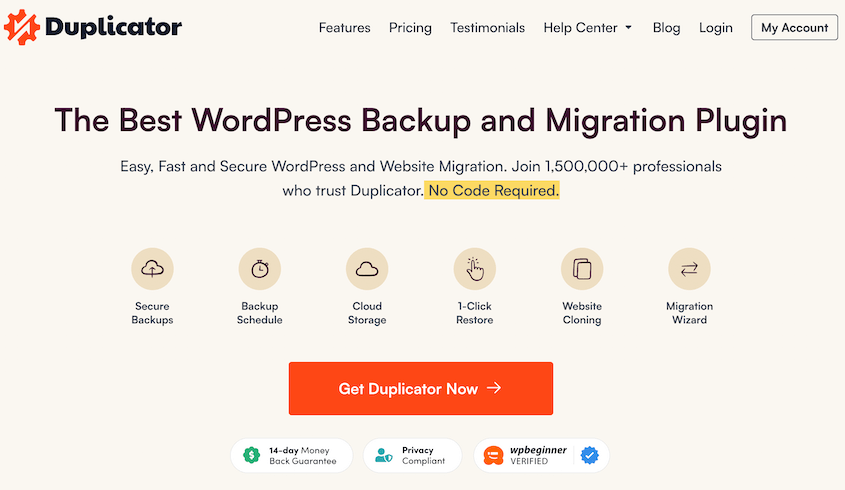Migrating a WordPress site can be a complex task, but with the right plugin, it becomes a manageable process. These plugins are designed to preserve your posts, images, and settings, ensuring a smooth transition to a new online location without the fear of broken links or missing files.
When considering a site migration, it’s important to identify your specific needs. Whether you’re moving hosts to save costs or changing your domain for branding purposes, the right plugin can ensure that all your site data is transferred intact, without the risk of losing any content.
Two popular plugins, All in One WP Migration and Duplicator, have gained a strong following due to their user-friendly interfaces and comprehensive features. They are designed to simplify the process of migrating your site, making it easier to switch hosts or domains without the need for advanced technical skills.
This guide shares key facts about both plugins. It covers how each helps with site moves and what sets them apart. By following these tips, owners may choose the one that feels right. A smooth site transfer can save worry and protect valuable content. Many have found these tools easier than manual moves, often needing coding and database tweaks.
Overview of All-in-One WP Migration and Duplicator
All-in-One WP Migration and Duplicator each have many fans. One shows over one million active installs, while the other exceeds three million. Both collect a WordPress site into a single file for moving. This bundle holds posts, pages, media, and settings. Large user groups keep them updated. Users also share tips in forums and leave reviews, which help other site owners learn more.
Duplicator creates a “package” with the database, themes, plugins, and uploads. All-in-One WP Migration forms a similar file but uses a quick export method. People can then import that file into a new WordPress setup. Each approach saves time by grouping site parts in one place, which can reduce the chance of leaving anything behind and ease backup.
Some favor Duplicator’s step-by-step style, which provides a sense of control and understanding. Others pick All in One WP Migration for its fewer clicks and simple layout. Each plugin comes with a free version that works for smaller sites. Users with big stores or heavy media may want a paid upgrade for extra space. Both options can help owners avoid manual database edits, which saves time.
Both plugins try to lower site downtime and errors. Each suits different levels of skill. Duplicator gives more control over each file. All-in-One WP Migration uses a simpler export-import path. New users often start with the free editions and then upgrade if the site size grows. Either way, site owners can switch hosts without advanced coding.
Using Duplicator

This plugin scans the site and the database for files. Then, it builds two items: an installer script and an archive file. The archive holds themes, plugins, and posts. The installer file sets up the site in a new location. Both parts must be kept together. Many owners like how it organizes data in one package, which sometimes lowers guesswork.
One user forgot to upload the installer file to the new host, which caused confusion when trying to import the site. It was necessary to rebuild the package and do it all again. Keeping both files together avoids rework. The Duplicator also helps with links to match the new domain, saving hours spent fixing broken paths later.
To finish the move, place both files on the new server. Then open the installer file in a web browser. Duplicator walks through each step, including database setup. After a short process, the site will appear in the new domain. Owners should check images, links, and pages for small issues. Testing everything can confirm a successful move with ease.
Using All-in-One WP Migration

All-in-one WP Migration often appeals to beginners. After installation, it appears in the WordPress dashboard. Owners click “Export” to gather the database, themes, plugins, and media. They can skip certain files if needed. This step creates a backup file to download. Many see it as simpler than some other methods, keeping the process short.
The user sets up WordPress on the new host to move the site. Then, the plugin is installed again. Owners pick “Import” and drop the saved file. The tool unpacks all content and adjusts old links. Posts, images, and settings usually arrive in one piece, leading to fewer headaches. Some people choose it for quick turnarounds and easy fixes.
After the import, the site may need to check the permalinks in “Settings.” Some users like to re-save them just to be sure. The plugin also lets owners leave out parts they do not need. This can keep the final file smaller. Many find this approach helpful for simple moves. It also cuts down on clutter and extra site weight.
Comparing Duplicator and All-in-One WP Migration
Both plugins are known for moving WordPress sites well. Many user reviews highlight strong performance. Duplicator earns praise for building a complete site package, while All in One WP Migration is liked for fewer steps. Each plugin fits different skill levels. Owners can pick based on what feels most comfortable. They both handle core WordPress parts with care and safety.
Large or complex sites might hit size limits with free plans. Paid upgrades can remove those limits or add extras. Duplicator’s free version is fine for smaller blogs or sites with fewer media files. All in One WP Migration offers a premium add-on that boosts file size and provides support. This helps owners who handle photo galleries or online shops.
Some site owners share success stories with All in One WP Migration when moving big stores, though a paid option may be required. Others like Duplicator because it can also work as a backup tool. Both aim to reduce downtime and mistakes. The choice often comes down to site size and personal taste. Each plugin makes WordPress transfers more peaceful.
Final Points
Many WordPress owners rely on plugins for site moves. Duplicator and All in One WP Migration stay popular due to their ease of use. Both have free and paid plans for different needs. Each tool lowers errors by collecting site details in one file, reducing the chance of broken pages or missing content. Owners share tips in online groups.
Experts suggest keeping a complete backup before any migration. Hosting servers can limit file uploads, so it helps to check those first. If a site is extra large, a premium plan might fit better. This can also include additional support if needed. Backing up can protect against mistakes or corrupt files. Some hosting providers also have built-in backups or snapshots.
Some people run a test on a staging site to see if everything looks good. The migration can begin if links, images, and content align well. This prevents surprises on a live site. A staging site is a copy of the main site that is not public. Users can fix problems there first. This adds extra safety.
All-in-One WP Migration vs Duplicator does not have one perfect answer. Duplicator gives a step-by-step style with backup features. All in One WP Migration has a shorter path. Site owners can pick what feels best for their comfort and site size. Each tool seeks to make WordPress moves easier. Either choice can lead to a smooth final transition.









